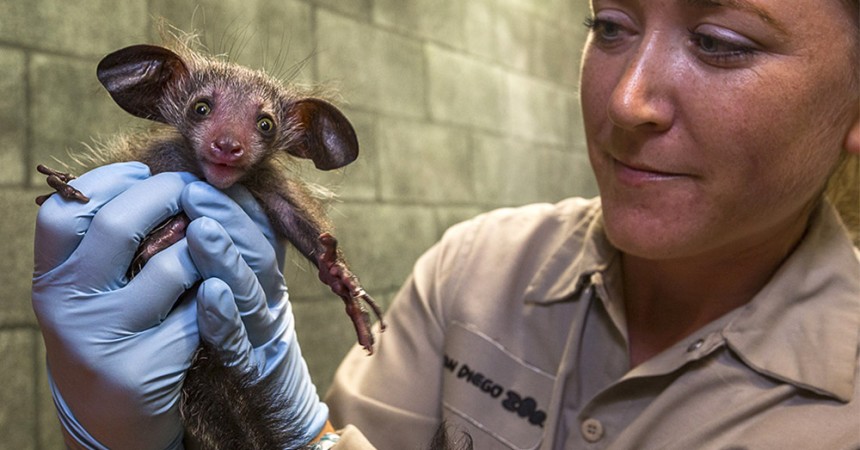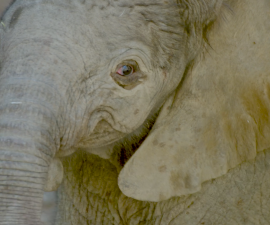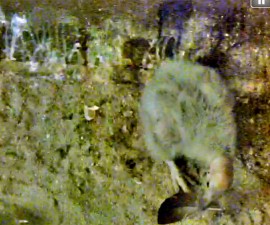Keepers at the San Diego Zoo checked the weight of a one-month-old female aye-aye today (Oct. 15), under the watchful eye of her mother. After distracting mom for a short time with a treat of honey, keepers were able to locate the baby in the nest box, reach in and scoop her up, so they could check her weight. This is an important procedure that is done frequently when the baby is young, to ensure that she is healthy and growing properly. The baby weighed 3.6 ounces at birth and weighed in at 9.03 ounces today. The weight gain is a sign that the mother aye-aye is doing a great job of caring for her adorable baby. The young aye-aye’s name is Fady (pronounced FAW DEE), which means taboo in Malagasy.
“Aye-ayes are extremely rare in zoological settings; only a handful of zoos in the U.S. house these animals,” said Mindy Settles, primate keeper at the San Diego Zoo. “Fady’s birth on September 8 marks the first aye-aye baby born at the San Diego Zoo. Counting this infant, there are only 27 aye-ayes in North America.” Fady was born to a first-time mother, Styx, and father, Nirina. Nirina (which means hope in Malagasy) is an important founder in the aye-aye Species Survival Plan program, developed through the Association of Zoos and Aquariums to help ensure the survival of species that may be endangered or threatened in the wild, providing genetic diversity to the species.
Aye-ayes live only on the island of Madagascar. They are the largest of the nocturnal primates and are the most specialized. Aye-ayes spend their lives in rain forest trees. They are dark brown or black in color, and are distinguished by a bushy tail that is larger than their body. Aye-ayes use a unique foraging method called “percussive foraging.” The aye-aye uses its most distinguishing feature—a thin, elongated and versatile middle finger on its hand—to tap on tree trunks and branches, while listening with its large rounded ears for hollows in dead or decaying wood. They search the hollows for their prey—grubs—and use their large teeth to rip open the bark until they find one. Then, the aye-aye uses its long finger to reach in and extract the grub.
Today aye-ayes are protected by law in Madagascar, however many people native to the island consider the aye-aye an omen of bad luck and will often kill one on sight. This, along with habitat destruction, has put the aye-aye on the endangered list.
Bringing species back from the brink of extinction is the goal of San Diego Zoo Global. As a leader in conservation, the work of San Diego Zoo Global includes on-site wildlife conservation efforts (representing both plants and animals) at the San Diego Zoo, San Diego Zoo Safari Park, and San Diego Zoo Institute for Conservation Research, as well as international field programs on six continents. The work of these entities is inspiring children through the San Diego Zoo Kids network, reaching out through the Internet and in children’s hospitals nationwide. The work of San Diego Zoo Global is made possible by the San Diego Zoo Global Wildlife Conservancy and is supported in part by the Foundation of San Diego Zoo Global.
Photo taken on October 15, 2015 by Ken Bohn, San Diego Zoo
CONTACT: SAN DIEGO ZOO GLOBAL PUBLIC RELATIONS, 619-685-3291






